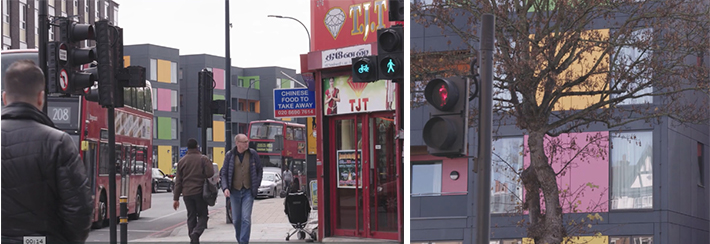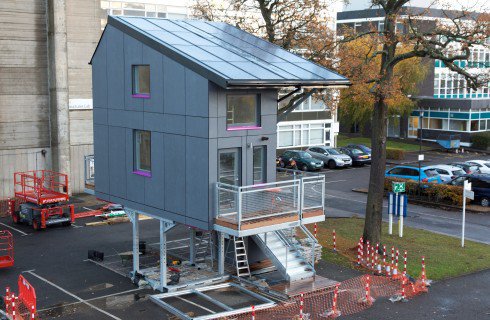Let’s rewind 4,500 years and try to picture the construction sites for the pyramids. From the air it must have looked like a web teeming with ants. With such primitive equipment to work with – systems of ropes and pulleys, men pulling/pushing carts; compared to today, it is a wonder how such complex and magnificent buildings have stood the test of time.
 Construction methods - Pyramids
Depending on the accounts you read, the work force to build the pyramids was between 30,000 and 100,000 strong and the Pyramid at Giza was under construction for 10-20 years. A far cry from industry practices today; yet we are seeing some disruptive developments in the housing construction sector, which are moving practices along again.
Based on a standard residential new-build, it is reported that 26-32 workers are needed and it takes 3-4 months on average to complete. This is just one sector needing a work force and the UK construction industry appears to be fast approaching a crisis point. The culmination of an ageing work force with the uncertainty that Brexit has bestowed (politically and economically), there has been a decline in the number of skilled tradespeople to work on the many projects that have received planning permission; both commercial and residential across the UK.
‘The Government must build 300,000 homes each year in England to help solve the housing crisis, an increase of 50pc from its current target’, a committee of Lords has advised (July 2016). This is to cope with a growing and aging population and does not factor in the additional amenities that are also required. Will we run out of available land or the workforce to build the necessary houses first?
With a bill passed to allow the construction on some areas of previously protected green belt, it appears we still have land to build on. Therefore, where are all the skilled workers going to come from that are needed to reach this target of new homes required?
Construction methods - Pyramids
Depending on the accounts you read, the work force to build the pyramids was between 30,000 and 100,000 strong and the Pyramid at Giza was under construction for 10-20 years. A far cry from industry practices today; yet we are seeing some disruptive developments in the housing construction sector, which are moving practices along again.
Based on a standard residential new-build, it is reported that 26-32 workers are needed and it takes 3-4 months on average to complete. This is just one sector needing a work force and the UK construction industry appears to be fast approaching a crisis point. The culmination of an ageing work force with the uncertainty that Brexit has bestowed (politically and economically), there has been a decline in the number of skilled tradespeople to work on the many projects that have received planning permission; both commercial and residential across the UK.
‘The Government must build 300,000 homes each year in England to help solve the housing crisis, an increase of 50pc from its current target’, a committee of Lords has advised (July 2016). This is to cope with a growing and aging population and does not factor in the additional amenities that are also required. Will we run out of available land or the workforce to build the necessary houses first?
With a bill passed to allow the construction on some areas of previously protected green belt, it appears we still have land to build on. Therefore, where are all the skilled workers going to come from that are needed to reach this target of new homes required?
 Modular and prefabrication construction methods
In an effort to redress this issue, some disruptive investors have been analysing manufacturing practices from other industries, such as car making and taking elements to devise a new method of house building. Traditional house building is subject to having the right trades at the right time and is at the mercy of the weather. The coordination to bring all the elements together is arduous and time consuming, with many factors having negative consequences, pushing the budget up and prolonging the build phase.
They have turned house building on its head and have eliminated some of the previously uncontrollable factors. There are a few companies that are building modular housing in pop-up factories, which is then transported to site fully kitted out and almost ready to live in. The elimination of the risk of bad weather and the automation of some of the steps, means the build is more efficient, quicker and (should be) cheaper.
Another company (Z Pods) has devised a concept where by housing on stilts is placed in carparks, providing affordable accommodation for key workers in hospitals etc and granting an income stream for the owners of the land. Again they come fully assembled and require no foundations. Quite revolutionary for the construction methods we are used to seeing in the UK.
Modular and prefabrication construction methods
In an effort to redress this issue, some disruptive investors have been analysing manufacturing practices from other industries, such as car making and taking elements to devise a new method of house building. Traditional house building is subject to having the right trades at the right time and is at the mercy of the weather. The coordination to bring all the elements together is arduous and time consuming, with many factors having negative consequences, pushing the budget up and prolonging the build phase.
They have turned house building on its head and have eliminated some of the previously uncontrollable factors. There are a few companies that are building modular housing in pop-up factories, which is then transported to site fully kitted out and almost ready to live in. The elimination of the risk of bad weather and the automation of some of the steps, means the build is more efficient, quicker and (should be) cheaper.
Another company (Z Pods) has devised a concept where by housing on stilts is placed in carparks, providing affordable accommodation for key workers in hospitals etc and granting an income stream for the owners of the land. Again they come fully assembled and require no foundations. Quite revolutionary for the construction methods we are used to seeing in the UK.
 Z Pod housing
On one hand it is fascinating to see the developments and benefits these new manufacturing practices bring. The promise of affordable zero bills homes in form of a flat pack, manufacturing processes less reliant on good weather and the exact work force at the right time - maybe this is the answer to some of the issues the industry faces and will help us meet the targets set? However, on the flip side will this lead to the death of some trades and see the demise of some of the traditions passed down from our ancestors?
Some of these concepts also open up a can of worms and challenge what we consider the norm, not just through construction but with regards to mortgageability (some of these buildings have no fixed foundations) and the type of lease on the building. In the quickly evolving world of construction, new materials, products and processes are taking us down roads we’d never have dreamed of a decade ago. To make some of these new concepts affordable the financial and legal sector will have to adapt and change. Financial products such as EeMAP, the ‘energy efficient mortgage’, are possibly indicative of a sector poised to embrace these new possibilities.
Do you live in a modern concept house, rich in innovation? We would like to hear your thoughts on how the evolution of construction has affected your standard of living. Do get in touch.
Z Pod housing
On one hand it is fascinating to see the developments and benefits these new manufacturing practices bring. The promise of affordable zero bills homes in form of a flat pack, manufacturing processes less reliant on good weather and the exact work force at the right time - maybe this is the answer to some of the issues the industry faces and will help us meet the targets set? However, on the flip side will this lead to the death of some trades and see the demise of some of the traditions passed down from our ancestors?
Some of these concepts also open up a can of worms and challenge what we consider the norm, not just through construction but with regards to mortgageability (some of these buildings have no fixed foundations) and the type of lease on the building. In the quickly evolving world of construction, new materials, products and processes are taking us down roads we’d never have dreamed of a decade ago. To make some of these new concepts affordable the financial and legal sector will have to adapt and change. Financial products such as EeMAP, the ‘energy efficient mortgage’, are possibly indicative of a sector poised to embrace these new possibilities.
Do you live in a modern concept house, rich in innovation? We would like to hear your thoughts on how the evolution of construction has affected your standard of living. Do get in touch.
 Construction methods - Pyramids
Depending on the accounts you read, the work force to build the pyramids was between 30,000 and 100,000 strong and the Pyramid at Giza was under construction for 10-20 years. A far cry from industry practices today; yet we are seeing some disruptive developments in the housing construction sector, which are moving practices along again.
Based on a standard residential new-build, it is reported that 26-32 workers are needed and it takes 3-4 months on average to complete. This is just one sector needing a work force and the UK construction industry appears to be fast approaching a crisis point. The culmination of an ageing work force with the uncertainty that Brexit has bestowed (politically and economically), there has been a decline in the number of skilled tradespeople to work on the many projects that have received planning permission; both commercial and residential across the UK.
‘The Government must build 300,000 homes each year in England to help solve the housing crisis, an increase of 50pc from its current target’, a committee of Lords has advised (July 2016). This is to cope with a growing and aging population and does not factor in the additional amenities that are also required. Will we run out of available land or the workforce to build the necessary houses first?
With a bill passed to allow the construction on some areas of previously protected green belt, it appears we still have land to build on. Therefore, where are all the skilled workers going to come from that are needed to reach this target of new homes required?
Construction methods - Pyramids
Depending on the accounts you read, the work force to build the pyramids was between 30,000 and 100,000 strong and the Pyramid at Giza was under construction for 10-20 years. A far cry from industry practices today; yet we are seeing some disruptive developments in the housing construction sector, which are moving practices along again.
Based on a standard residential new-build, it is reported that 26-32 workers are needed and it takes 3-4 months on average to complete. This is just one sector needing a work force and the UK construction industry appears to be fast approaching a crisis point. The culmination of an ageing work force with the uncertainty that Brexit has bestowed (politically and economically), there has been a decline in the number of skilled tradespeople to work on the many projects that have received planning permission; both commercial and residential across the UK.
‘The Government must build 300,000 homes each year in England to help solve the housing crisis, an increase of 50pc from its current target’, a committee of Lords has advised (July 2016). This is to cope with a growing and aging population and does not factor in the additional amenities that are also required. Will we run out of available land or the workforce to build the necessary houses first?
With a bill passed to allow the construction on some areas of previously protected green belt, it appears we still have land to build on. Therefore, where are all the skilled workers going to come from that are needed to reach this target of new homes required?
 Modular and prefabrication construction methods
In an effort to redress this issue, some disruptive investors have been analysing manufacturing practices from other industries, such as car making and taking elements to devise a new method of house building. Traditional house building is subject to having the right trades at the right time and is at the mercy of the weather. The coordination to bring all the elements together is arduous and time consuming, with many factors having negative consequences, pushing the budget up and prolonging the build phase.
They have turned house building on its head and have eliminated some of the previously uncontrollable factors. There are a few companies that are building modular housing in pop-up factories, which is then transported to site fully kitted out and almost ready to live in. The elimination of the risk of bad weather and the automation of some of the steps, means the build is more efficient, quicker and (should be) cheaper.
Another company (Z Pods) has devised a concept where by housing on stilts is placed in carparks, providing affordable accommodation for key workers in hospitals etc and granting an income stream for the owners of the land. Again they come fully assembled and require no foundations. Quite revolutionary for the construction methods we are used to seeing in the UK.
Modular and prefabrication construction methods
In an effort to redress this issue, some disruptive investors have been analysing manufacturing practices from other industries, such as car making and taking elements to devise a new method of house building. Traditional house building is subject to having the right trades at the right time and is at the mercy of the weather. The coordination to bring all the elements together is arduous and time consuming, with many factors having negative consequences, pushing the budget up and prolonging the build phase.
They have turned house building on its head and have eliminated some of the previously uncontrollable factors. There are a few companies that are building modular housing in pop-up factories, which is then transported to site fully kitted out and almost ready to live in. The elimination of the risk of bad weather and the automation of some of the steps, means the build is more efficient, quicker and (should be) cheaper.
Another company (Z Pods) has devised a concept where by housing on stilts is placed in carparks, providing affordable accommodation for key workers in hospitals etc and granting an income stream for the owners of the land. Again they come fully assembled and require no foundations. Quite revolutionary for the construction methods we are used to seeing in the UK.
 Z Pod housing
On one hand it is fascinating to see the developments and benefits these new manufacturing practices bring. The promise of affordable zero bills homes in form of a flat pack, manufacturing processes less reliant on good weather and the exact work force at the right time - maybe this is the answer to some of the issues the industry faces and will help us meet the targets set? However, on the flip side will this lead to the death of some trades and see the demise of some of the traditions passed down from our ancestors?
Some of these concepts also open up a can of worms and challenge what we consider the norm, not just through construction but with regards to mortgageability (some of these buildings have no fixed foundations) and the type of lease on the building. In the quickly evolving world of construction, new materials, products and processes are taking us down roads we’d never have dreamed of a decade ago. To make some of these new concepts affordable the financial and legal sector will have to adapt and change. Financial products such as EeMAP, the ‘energy efficient mortgage’, are possibly indicative of a sector poised to embrace these new possibilities.
Do you live in a modern concept house, rich in innovation? We would like to hear your thoughts on how the evolution of construction has affected your standard of living. Do get in touch.
Z Pod housing
On one hand it is fascinating to see the developments and benefits these new manufacturing practices bring. The promise of affordable zero bills homes in form of a flat pack, manufacturing processes less reliant on good weather and the exact work force at the right time - maybe this is the answer to some of the issues the industry faces and will help us meet the targets set? However, on the flip side will this lead to the death of some trades and see the demise of some of the traditions passed down from our ancestors?
Some of these concepts also open up a can of worms and challenge what we consider the norm, not just through construction but with regards to mortgageability (some of these buildings have no fixed foundations) and the type of lease on the building. In the quickly evolving world of construction, new materials, products and processes are taking us down roads we’d never have dreamed of a decade ago. To make some of these new concepts affordable the financial and legal sector will have to adapt and change. Financial products such as EeMAP, the ‘energy efficient mortgage’, are possibly indicative of a sector poised to embrace these new possibilities.
Do you live in a modern concept house, rich in innovation? We would like to hear your thoughts on how the evolution of construction has affected your standard of living. Do get in touch.- Date
- Category
- The Built Environment
- Tags
- construction methods